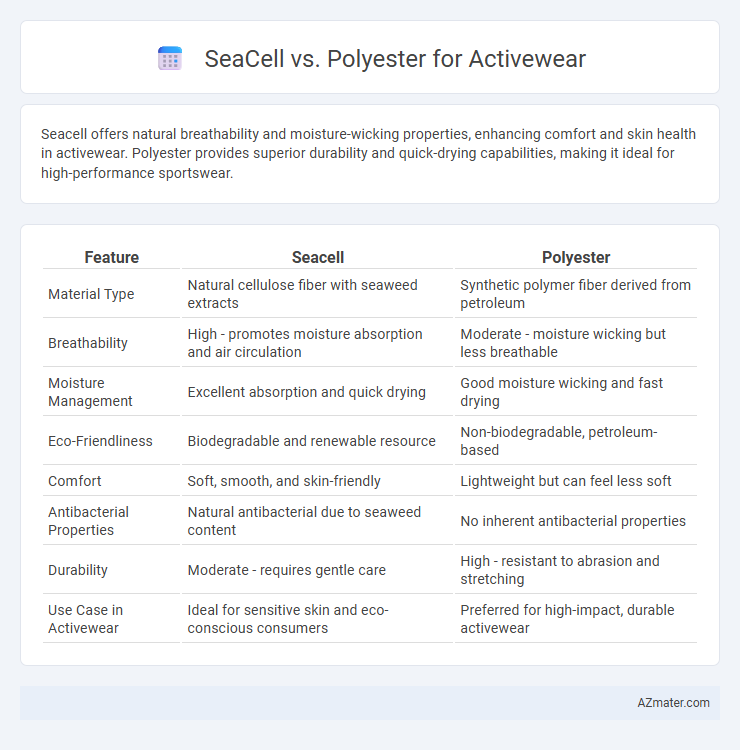Seacell offers natural breathability and moisture-wicking properties, enhancing comfort and skin health in activewear. Polyester provides superior durability and quick-drying capabilities, making it ideal for high-performance sportswear.
Table of Comparison
| Feature | Seacell | Polyester |
|---|---|---|
| Material Type | Natural cellulose fiber with seaweed extracts | Synthetic polymer fiber derived from petroleum |
| Breathability | High - promotes moisture absorption and air circulation | Moderate - moisture wicking but less breathable |
| Moisture Management | Excellent absorption and quick drying | Good moisture wicking and fast drying |
| Eco-Friendliness | Biodegradable and renewable resource | Non-biodegradable, petroleum-based |
| Comfort | Soft, smooth, and skin-friendly | Lightweight but can feel less soft |
| Antibacterial Properties | Natural antibacterial due to seaweed content | No inherent antibacterial properties |
| Durability | Moderate - requires gentle care | High - resistant to abrasion and stretching |
| Use Case in Activewear | Ideal for sensitive skin and eco-conscious consumers | Preferred for high-impact, durable activewear |
Introduction to Seacell and Polyester
Seacell is a sustainable fabric made from cellulose fibers derived from seaweed, known for its breathability, moisture-wicking properties, and natural antioxidant benefits, making it ideal for activewear. Polyester, a synthetic polymer, is widely used in activewear for its durability, wrinkle resistance, and excellent moisture management through engineered fibers. Comparing Seacell and Polyester highlights the balance between eco-friendly materials and high-performance functionality in athletic apparel.
Origins and Production Processes
Seacell activewear originates from sustainable seaweed fibers, integrating marine cellulose with lyocell through an environmentally friendly wet-spinning process that preserves nutrient-rich compounds beneficial for skin health. Polyester is a synthetic fiber derived from petroleum-based chemicals, produced via a high-energy melt-spinning and extrusion process that involves polymerization of purified terephthalic acid and ethylene glycol. The bio-based origins and renewable nature of Seacell offer a stark contrast to the fossil-fuel dependency and carbon-intensive production typical of polyester in activewear manufacturing.
Environmental Impact Comparison
Seacell fabric, derived from seaweed and biodegradable fibers, offers a significantly lower environmental footprint compared to polyester, which is petroleum-based and non-biodegradable. Polyester production releases higher greenhouse gas emissions and microplastic pollution during washing, contributing to long-term ocean contamination. Seacell's renewable raw materials and natural biodegradability make it a more sustainable option for eco-conscious activewear brands aiming to reduce ecological impact.
Moisture Management and Breathability
Seacell fibers, derived from seaweed and cellulose, offer superior moisture management by quickly wicking sweat away from the skin and promoting rapid evaporation, which helps maintain dryness during intense workouts. Polyester, while durable and commonly used in activewear, tends to retain moisture longer, potentially causing discomfort and slower evaporation rates. In terms of breathability, Seacell's natural fibers allow better air circulation compared to polyester's synthetic structure, enhancing overall comfort and temperature regulation during physical activity.
Comfort and Skin Sensitivity
Seacell fibers, infused with seaweed extracts, offer exceptional moisture-wicking properties and natural antibacterial benefits, making them ideal for sensitive skin during activewear use. Polyester, while durable and quick-drying, tends to trap heat and moisture, potentially causing irritation for those with skin sensitivities. Seacell's breathable, hypoallergenic nature enhances comfort by reducing sweat build-up and minimizing allergic reactions compared to traditional polyester fabrics.
Antibacterial and Odor Resistance
Seacell activewear excels in antibacterial and odor resistance due to its natural seaweed fibers infused with antioxidants that inhibit bacterial growth and neutralize odors. Polyester activewear, made from synthetic fibers, often relies on chemical treatments for odor control that can wear off after repeated washes. Seacell's inherent antimicrobial properties provide longer-lasting freshness and reduced odor compared to the temporary effects of treated polyester fabrics.
Durability and Longevity
Seacell fibers, infused with seaweed extracts, offer moderate durability but excel in comfort and breathability for activewear, making them suitable for low-impact activities. Polyester, a synthetic fiber, provides superior durability and resistance to stretching, shrinking, and abrasion, ideal for high-intensity workouts and long-term use. When prioritizing longevity and toughness in activewear, polyester outperforms Seacell, maintaining shape and function through frequent washes and strenuous exercise.
Performance in Activewear Applications
Seacell fabric offers superior moisture-wicking and antibacterial properties, making it ideal for activewear that demands odor control and skin comfort during intense workouts. Polyester excels in durability, quick drying, and lightweight performance, ensuring long-lasting wear and efficient moisture management in high-performance activities. The choice between Seacell and polyester depends on the desired balance of natural fiber benefits and synthetic resilience for activewear performance.
Care, Maintenance, and Sustainability
Seacell activewear, derived from cellulose fibers infused with seaweed, offers natural breathability and biodegradability, making it a sustainable choice compared to synthetic polyester. Polyester, a petroleum-based fiber, requires less frequent washing due to its moisture-wicking properties but poses environmental challenges in disposal and microplastic pollution. Proper care of Seacell involves gentle washing and air drying to maintain fiber integrity, while polyester is durable and machine washable but contributes to synthetic waste accumulation over time.
Cost Analysis and Consumer Considerations
Seacell activewear typically costs more than polyester due to its eco-friendly production and added skin benefits from seaweed fibers, appealing to consumers prioritizing sustainability and comfort. Polyester offers a budget-friendly option with excellent moisture-wicking and durability properties, making it popular among athletes seeking affordable, high-performance activewear. Consumers balancing price with environmental impact often weigh Seacell's natural fiber advantages against polyester's cost-effectiveness and widespread availability.

Infographic: Seacell vs Polyester for Activewear
 azmater.com
azmater.com